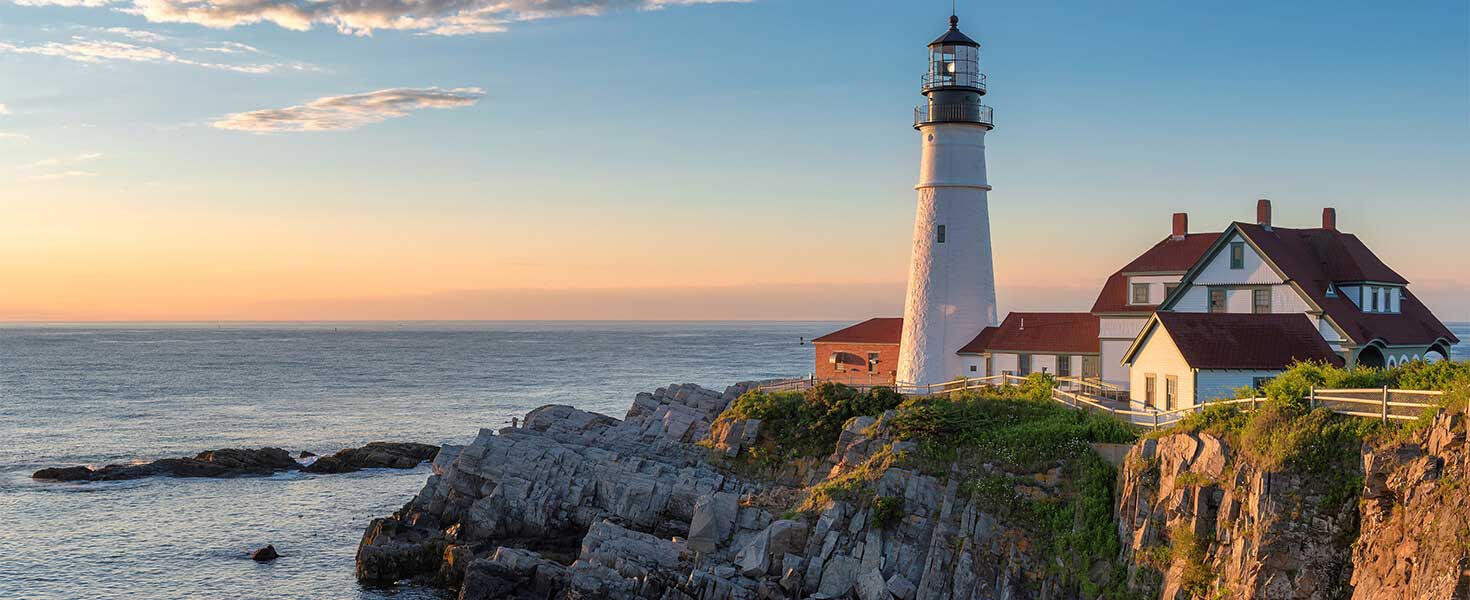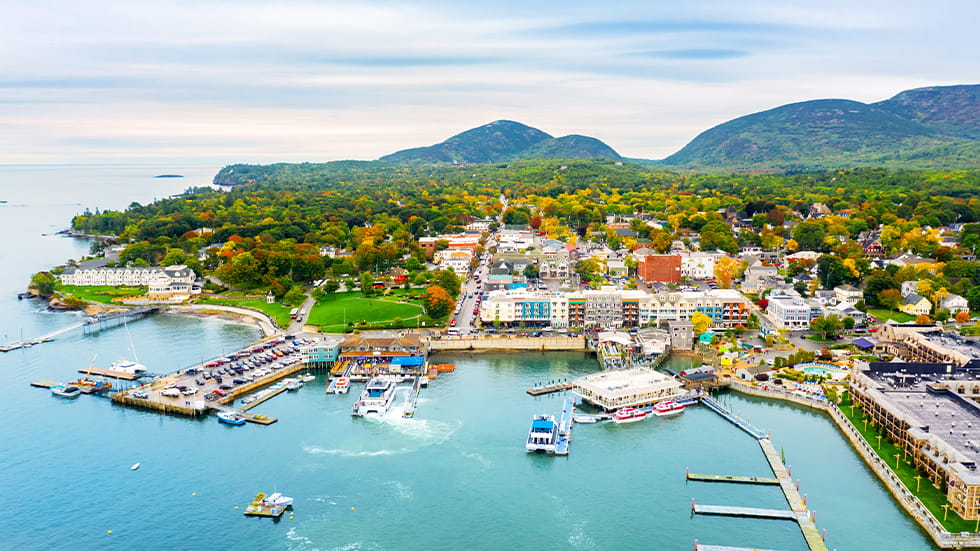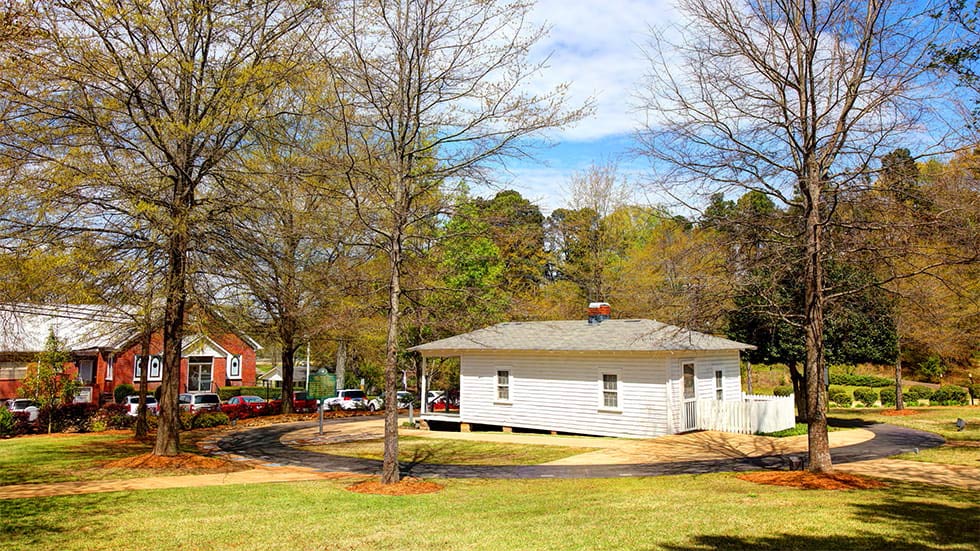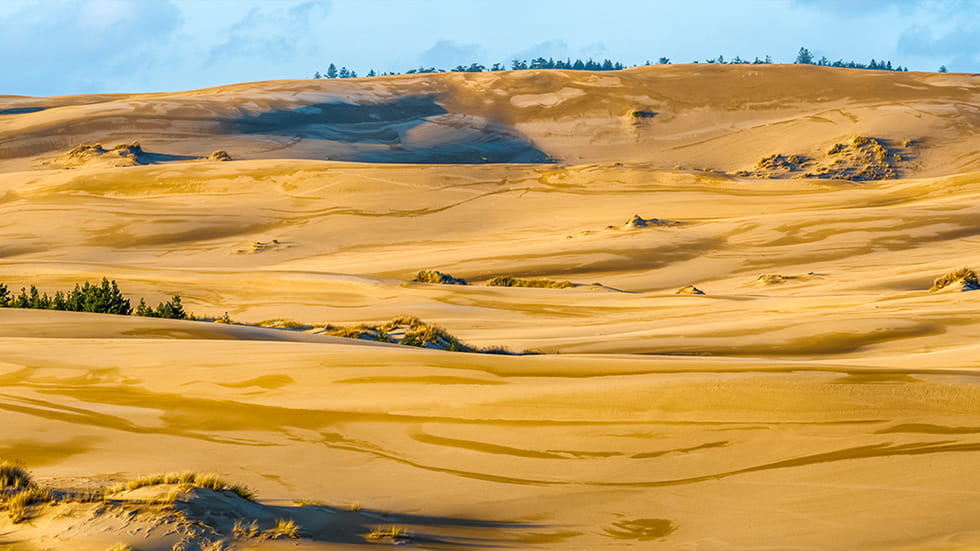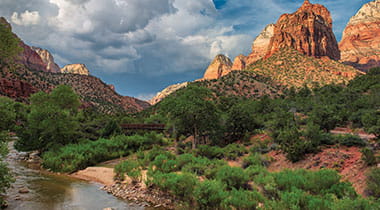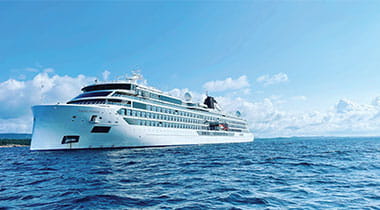With that in mind, let’s hit the highway!
Aerial view of Bar Harbor, Maine
EAST: LIGHTHOUSES AND LOBSTERS
The Drive: Portland, Maine to Halifax, Nova Scotia
590 MILES (one-way)
Closest Major Airport: Portland, Maine
Taken together, the U.S. and Canada have more than 100,000 miles of coastline. None, however, is more remarkable than this stretch that runs from Maine to New Brunswick and Nova Scotia, Canada.
Start your road trip in Portland, the largest city in Maine. Leave time to explore some of the six area lighthouses, including the photogenic Portland Head Light, which was commissioned in 1791 by George Washington.
From there, follow Highway 1 north as it winds its way along Maine’s rugged coast. The drive will take you through several small towns, including Rockport, home of what is arguably the state’s most picturesque harbor. No matter where you stop, be sure to sample Maine’s two classic foodstuffs: lobster rolls and blueberry pie.
Push on to the turnoff for Mount Desert Island and the quaint town of Bar Harbor, where you can get your sea legs aboard an authentic Maine windjammer such as the four-masted schooner Margaret Todd. The island is also home to Acadia National Park, which contains examples of all Maine’s best topography in its 73 square miles.
From Acadia, it’s roughly a three-hour scenic drive to the Canadian border. Bring your passport to cross into New Brunswick at the Milltown/Saint Stephen border crossing, and follow Canada’s Highway 1 up the coast.
Once you’re along the coast again, off to your right will be the world-famous Bay of Fundy. The lower part of the bay is home to four whale species, making for amazing whale-watching cruises.
The real showstopper in this area of Canada, however, is the sight of the world’s highest tides. The water level in the upper reaches of the bay rises and falls more than 50 feet twice daily, a spectacle that allows you the unique opportunity to walk on the sea floor at places such as Hopewell Rocks.
For a memorable finale, travel 26 miles southwest of Halifax, Nova Scotia, to the traditional fishing village of Peggy’s Cove, a colorful postcard-perfect commu¬nity that looks to have changed little since its early 20th-century heyday.
Don't miss: L.L. Bean’s flagship store in Freeport, Maine, where you can partake of outdoor adventures ranging from kayak tours to archery clinics.
Elvis Presley’s birth home in Tupelo, Mississippi
For more road trips, visit AAA drive trips at AAA.com/Roadtrips.
CENTRAL: DRIVE-THROUGH HISTORY
The Drive: Nashville, Tennessee to Natchez, Mississippi
444 MILES (one-way)
Closest Major Airport: Nashville, Tennessee
Some road trips can transport you to a different time, not just another place. This drive down the Natchez Trace Parkway is one of them.
It starts in Nashville, where you can begin your ramble through the past. In the period before steamboats made travel upriver a reality, the Trace served as a main thoroughfare for merchants who floated their goods down to Natchez and walked back home on this well-worn footpath.
You’ll find a tribute to one traveler of note at the Meriwether Lewis Monument (Milepost 385.9). Lewis, of Lewis and Clark fame, suffered a mysterious death at a small inn near here in 1809, just five years after returning from his historic journey.
You can get a feel for this era on Old Trace Drive at Milepost 375.8. This two-and-a-half-mile detour allows you to motor along the same route that carried then-General Andrew Jackson and his troops home from the 1815 Battle of New Orleans.
Music lovers will want to hop off the parkway at Milepost 259.7 to check out the Tupelo, Mississippi, birthplace of pop culture legend Elvis Presley. You can tour the modest home, museum and chapel for a small fee or just wander the grounds and poke about the gift shop.
To see what everyday life along the original Natchez Trace was like, stop at French Camp Historic Village at Milepost 180.7, where you’ll find historic log-cabin buildings from the days when this was America’s Western frontier.
Veer off the Trace at Milepost 66.0 to visit Vicksburg National Military Park. The 47-day siege of the heavily fortified city by the Union army in 1863 broke the Confederacy’s hold on the strategically important Mississippi River.
To walk the same ground those original Trace travelers did, don’t miss the Sunken Trace at Milepost 41.5. The short 100-yard trail worn into the earth here gives you a feel for what it was like to travel the Trace on foot more than two centuries ago.
As you approach the town of Natchez (Milepost 0), remember that this throwback to the antebellum South is worthy of a couple days’ exploration, with more than a dozen beautifully preserved plantation homes and a once-rowdy riverfront area known as Natchez-Under-The-Hill, where you can nosh on Southern classics such as fried shrimp Po’boys or simply sit and sip an adult beverage as you watch the sun set over the Mississippi.
Don't miss: The chance to pedal the parkway, the length of which is considered a bicycle route made all the more cyclist-friendly by its gently rolling hills and lack of cross-traffic.
Sand scapes in the Oregon Dunes National Recreation area
WEST: CHANGE OF SCENERY
The Drive:Redding, California to Reedsport, Oregon
375 MILES (one-way)
Closest Major Airport: Sacramento, California
While there may be as many different road-trip¬pers as there are roads, there’s one thing they all have in common: the pursuit of scenery. This drive through Northern California and up the southern Oregon coast is all about the scenery.
To begin, take Highway 44 west, where architecture aficionados will want to stop for a stroll across the Sacramento River on Redding’s Sundial Bridge, designed by Spanish architect Santiago Calatrava. Fishing fanatics will likely find the river here full of fat rainbow trout.
Follow the signs to 299 West, and you’ll eventually find yourself skirting the Trinity River. Look for rafters on the Class II-III rapids as the road passes through the conifer forests of the Coastal Mountains.
As Highway 299 culminates in the coastal college town of Arcata, turn north on Highway 101. After about 45 minutes, you’ll be motoring amid the towering trees of Redwood National and State Parks, where you can take the 10-mile Newton B. Drury Scenic Parkway through the heart of ancient redwood groves.
When you cross the border into Oregon, the scenery gets even better, with views of rugged bluffs and rocky sea stacks. One measure of the jaw-dropping quality of this landcape is the dozens of state parks here along the coast, a number that works out to one every 10 miles or so.
Pass through the town of Brookings, and pull into the lot at Pistol River State Scenic Viewpoint. The views here are dramatic, though what you’ll be looking at isn’t necessarily what you’d expect, as the strong winds just offshore make it a playground for serious kite-boarders.
For a more hands-on experience of the Oregon coast, explore the tide pools at Rocky Point Beach (look for the gravel road on the left, just past Mile Post 302). At low tide, the shoreline’s nooks and crannies present an abundance of fascinating creatures, from sea stars to the occasional baby octopus.
For a last blast on your road trip, spend some time exploring the 40 miles of windswept terrain that is the Oregon Dunes National Recreation Area. To really experience the continent’s largest expanse of coastal sea dunes, some as tall as a 50-story building, rent an ATV or take a guided tour in a multi-seat dune buggy.
Don’t miss: The Bigfoot Museum on Highway 299 in Willow Creek, California, just a few miles from where the most famous footage of the creature was shot in the fall of 1967
Ultimately, how long you spend doing these drives doesn’t matter. What counts in just getting out there to experience what is waiting for you around the next bend. Do that and you’re guaranteed to have a road trip to remember.








